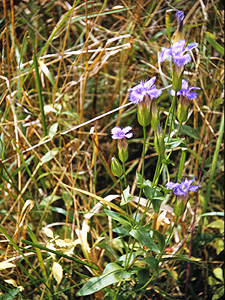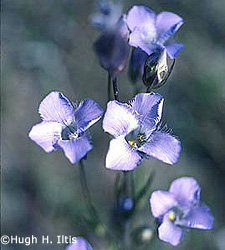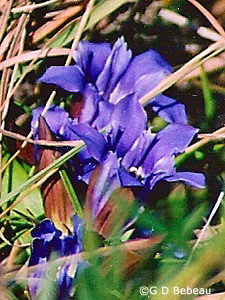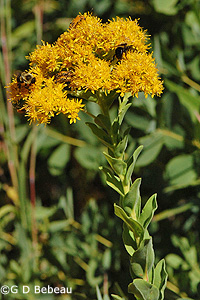
The Writings of Eloise Butler
Fringed Gentian, Termed Loveliest of Blue Flowers, Now in Bloom; Asters and Goldenrod Indicate Autumn Has Reached Minnesota.
Published in the Minneapolis Sunday Tribune September 10, 1911
[Note: To facilitate identification of plants, we have taken the liberty of adding the information that is within square brackets and also all the botanical names have been put into italics. The language of Eloise's day is left as written. Additional notes at the bottom of the page.]

September brings us what is pronounced the loveliest blue flower of the world - the Fringed Gentian. [Gentianopsis crinita. The indescribable color of rich, deep blue, the exquisite finish of the petals, the large number of flowers borne on a single individual, together with the late time of blooming, make this species of extraordinary value. The poet Bryant has given it immortal fame. Everyone knows his beautiful poem, “To the Fringed Gentian.” [Link below] It is somewhat captious to criticize this venerated master of literature and keen observer and lover of nature. Perhaps the case was different in Bryant’s Berkshire home but, with us, this “blossom bright with autumn dew, and colored with the heaven’s own blue,” does not “come alone, when woods are bare and birds are flown.” Late August finds it here with a large company of other flowers, and the trees are still in full leafage. The color of the flower, also, is not “sky blue.”
But who can say what sort of blue may not be found in the sky? Among the many tints gentian-blue will sometimes be seen there.
Then doth thy sweet and quiet eye
Look through its fringes to the sky,
Blue - blue - as if that sky let fall
A flower from its cerulean wall.

A smaller fringed gentian [Gentianopsis virgata virgata, formerly G. procera] with slight stem, linear leaves and fewer and paler colored blossoms, grows with the showier species. These flowers are annuals. Florists desirous to cultivate them were long baffled in their attempts. It was at length discovered that the seeds were biennial, that is, that they do not germinate until two years old. We must always leave some of the flowers to go to seed, however much their beauty tempts us, in order that the plant may not be exterminated.
Less local in the meadows is the Closed Blue Gentian, or chimney flower (Gentiana andrewsii). The tubular flower never expands. It displays all shades of blue. It is sometimes tinted with pink, and sometimes white, or white striped with blue.
There are other small-flowered gentians, with white or blue flowers. The Prairie Gentian, Gentiana puberula [Downy Gentian, now classified Gentiana puberulenta], has a large handsome, arm-shaped blossom of the deepest, darkest blue imaginable for petals. It looks almost black when seen across the prairie.



Sure signs of approaching autumn are the asters and goldenrods, the lambent flames of dying summer, that leap up and blaze with unwonted vividness before they are banked with snow. Gray (Ref. #1) enumerates fifty-six species of goldenrod and fifty-nine of aster, a large proportion of which are native to Minnesota. Both are difficult for beginners in botany to determine, but a few of them have such well marked characters that he who runs may read their names.
For example, the sweet, flat-topped prairie goldenrod, Solidago rigida [Stiff Goldenrod, now classified as Oligoneuron rigidum var. rigidum]. Another flat-topped species is the narrow-leaved, early blooming S. graminifolia [now classified Euthamia graminifolia var. graminifolia, Grass-leaved Goldenrod] found in damp soil. Among the more usual types with many-branched, elongated flower clusters are S. latifolia [now classified as Solidago flexicaulis, Zig-zag Goldenrod], a wood species, with broad, ovate leaves pointed at both ends, zigzag stems and with flower heads in bunches among the leaves; and in bogs, S. uliginosa [Bog Goldenrod], that exemplifies the name in the inflorescence forming a straight, slender reed.

The aster flower head is constructed like that of a daisy. It may be tiny or have a diameter of two inches or more. The ray petals are dark or pale blue, lilac, or white, according to the species.
The New England Aster [Symphyotrichum novae-angliae ] is tall and many flowered, with long, bright purple rays; Aster puniceus [now classified as Symphyotrichum puniceum, Red-stemmed Aster] is a swamp species with flowers of paler blue and hairy, red stems; A. umbellatus [now classified as Doellingeria umbellata var. pubens, Flat-topped Aster] is a tall, flat-topped, white swamp aster; and on the prairies are the small leaved and small flowered A. multiflorus [now classified as Symphyotrichum ericoides, White Heath Aster or Many-flowered Aster], as lovely as the spiraea, known as bridal wreath; and, loveliest of all, A. sericeus [now classified as Symphyotrichum sericeum, Western Silver Aster or Silky Aster], a silver gray, silky-leaved aster with large, bright, red-purple flowers.
No mention has yet been made of the grasses and sedges. Nature has not granted them bright colors, fragrance or nectar, because they are pollinated by the wind instead of by insects, but in place of these attractions, grace and beauty of form, qualities not to be ignored.

They are social plants and live together in large companies. Many sedges have three cornered, solid stems, while all the grasses have round stems which are hollow except at the leaf joints. Colonies of Zizania aquatica [wild or Indian rice], may be noted in the shallow waters of lakes and ponds. The leaves are long and slender and tall, attenuated flower spikes pierce the air like needles. The wild rice was carefully harvested by the Indians for breadstuff, and the grain-eating birds eagerly cull its seeds.
No one fond of mushrooms fears to gather and eat freely the shaggy mane, Coprinus comatus, for it is easily recognized. There is a lively contest for it on the parade ground (Ref. #2), where it abounds, and the first comers in the morning often carry off basketfuls in the season. The photograph shows several stages of growth [note - we show two separate photos]. The cylindrical cap covered with large scales like turkey feathers finally expands into a disk and deliquesces, dripping with a black fluid containing the spores. The mushroom is eaten of course, before this change takes place and when the flesh is firm and white. The black liquid treated with a preservative may be used as ink. It has been suggested that the government should use this fluid for printing bank notes to insure against counterfeiting. The microscope would at once expose a fraud, for the spores in the ink have a definite size and shape.
The other copriri are common and also edible - the ink cap, Coprinus atramentaries [Now classified as C. atramentarius], whose cap is usually smooth, gray and cup-shaped; and the little ink cap, C. micaceus, a small yellowish brown mushroom, common on lawns, especially above decaying roots of trees, throughout the season. The cap of this species is sometimes covered with gleaming, mica-like scales. The gills turn black when mature, but the plant generally dries without deliquescing.


Tours to the Garden. Following the closure of the State Fair where Eloise maintained an exhibit, the following was also printed with this article:
Miss Butler will conduct parties through the wild garden in Glenwood Park. Those wishing to see the place may set a time by telephone to suit convenience. Phone N.W. Colfax 1689..
Notes:
1. Here she is referring to botanist Asa Gray of Harvard.
2. "The Parade Ground" - this phrase refers to the parade ground at Fort Snelling, which in the early years of the Wild Flower Garden was a prime source of plants for Eloise.
More information and photos on some of these plants can be found under these links:
Bottle Gentian
Photo page of the Goldenrods and Asters of the Eloise Butler Wildflower Garden.
Two Poems about the Fringed Gentian by:
Wm Cullen Bryant